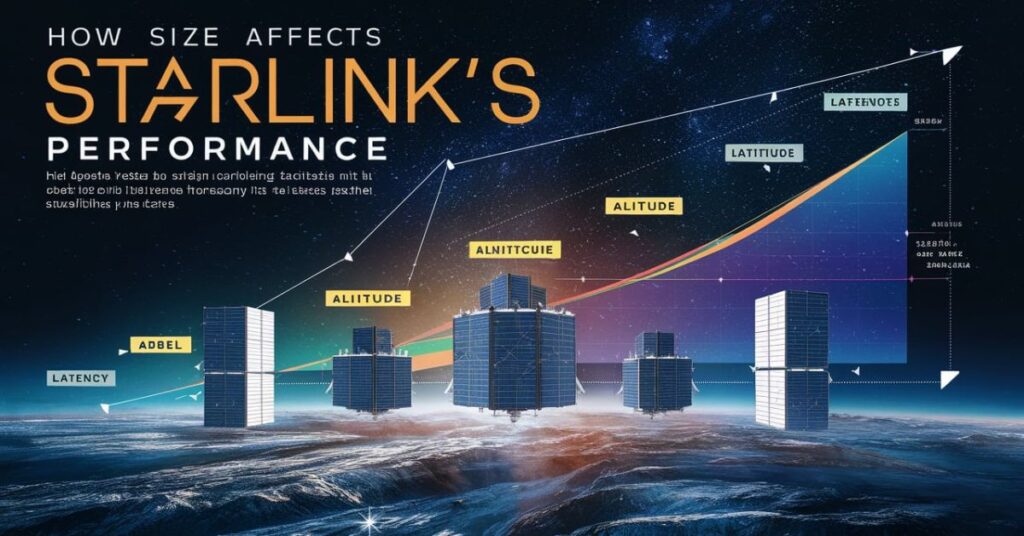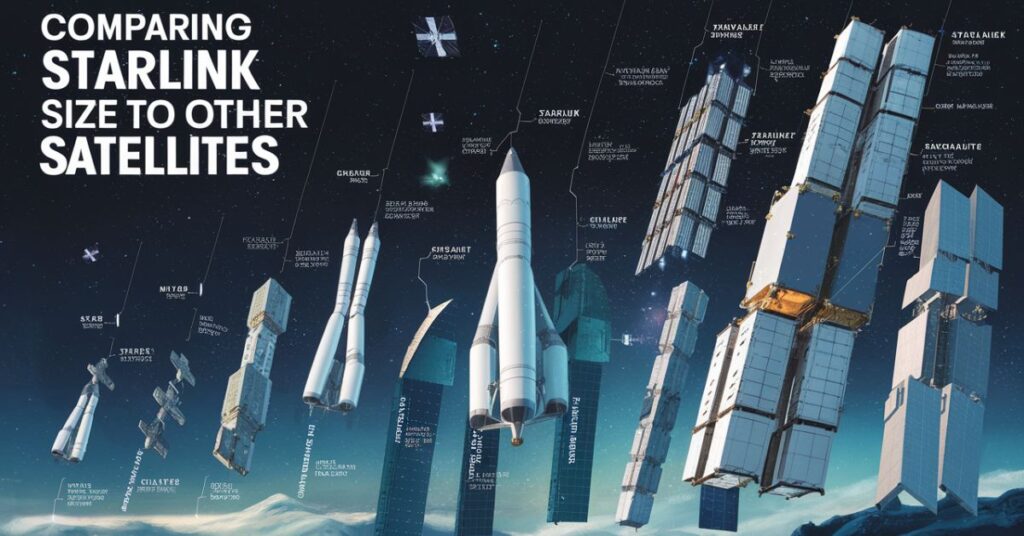Starlink satellite size are small but mighty machines orbiting Earth. These compact devices, made by SpaceX, bring the internet to people worldwide. Their size is key to their success.
Have you ever wondered how big a satellite can be? Starlink satellite size is surprisingly small. They’re about the size of a large coffee table, but they do a big job. These tiny space travelers work together to create a web of internet coverage around our planet.
In this article, we’ll explore the size of Starlink satellite size in detail. We’ll see why their compact design matters so much. We’ll also learn how these small satellites are changing how we connect to the internet. Let’s dive into the world of these fascinating space gadgets!
The Dimensions of Starlink Satellites
Starlink satellites are much smaller than traditional communication satellites. Each Starlink satellite size measures about 3 meters (10 feet) long and 1.5 meters (5 feet) wide. This is roughly the size of a large dining table.
When it comes to thickness, Starlink satellite sizes are quite slim. They’re only about 0.2 meters (8 inches) thick. This thin profile helps them fit snugly inside the rocket for launch. It’s amazing how much technology fits into such a small package!
The compact size of these satellites is no accident. SpaceX designed them to be as small as possible while still being effective. This small size is a big part of what makes the Starlink project possible.
Weight of Starlink Satellites
Size isn’t just about dimensions – weight matters too. Each Starlink satellite size weighs about 260 kilograms (573 pounds). That’s about as heavy as a large motorcycle. This lightweight is crucial for the success of the Starlink project.
The low weight of these satellites makes them easier to launch. SpaceX can send many satellites into space on a single rocket. This reduces the cost of getting the Starlink satellite size into orbit. It also means they can build their network faster.
Despite their lightweight, Starlink satellites are packed with advanced technology. They have powerful antennas, solar panels, and engines. All of this fits into a package that’s lighter than many Earth-bound machines!
Why Size Matters for Starlink Satellites
The size of Starlink satellites is very important.
- The small size allows more satellites to fit on one rocket
- Lighter satellites use less fuel to stay in orbit
- Compact design makes manufacturing faster and cheaper
- Smaller satellites are easier to replace if needed
- The size allows for a dense network of satellites in space
How Size Affects Starlink’s Performance

The small size of Starlink satellites plays a big role in how they work. Let’s look at some key aspects.
1. Orbital Placement
Starlink satellites are much closer to Earth than other satellites. They fly just 550 kilometers above us. This is possible because they are so small and light.
Being close to Earth helps the satellites work better. They can send internet signals faster. This means people on the ground get quicker internet.
The small Starlink satellite size is key to this low orbit. Bigger satellites would have trouble staying so close to Earth. But Starlink’s tiny size makes it work well.
2. Network Density
Starlink uses lots of small satellites to cover the Earth. This creates a thick blanket of satellites in space. It’s like having many small lights instead of a few big ones.
More satellites mean better internet coverage. People can get online from more places. The signal is stronger and more reliable.
SpaceX can do this because the satellites are so small. They can fit many on one rocket. This lets them build their network quickly and efficiently.
3. Maneuverability
Starlink satellites can move around in space. They use tiny engines to change their position. This is easier to do because they are so small and light.
Moving helps the satellites avoid space junk. There are a lot of old rockets and broken satellites up there. Starlink satellites can dodge these to stay safe.
The satellites can also move to give better coverage. If one area needs more internet, they can shift position. This flexibility is thanks to their small size.
4. Replacement and Upgrades
When a Starlink satellite gets old, it’s easy to replace. SpaceX can quickly send up a new one. This keeps the whole system working well.
The small size makes this replacement simple. It doesn’t cost too much to launch a new satellite. SpaceX can do it often to keep their technology fresh.
This means Starlink users always have the latest tech. The internet service can keep getting better. It’s all because the satellites are small and easy to swap out.
5. Cost-Effectiveness
Small Starlink satellite sizes are cheaper to make and launch. This saves SpaceX a lot of money. They can build and send up many satellites without spending too much.
The low cost helps keep Starlink’s internet affordable. People don’t have to pay as much to use the service. This makes it available to more people around the world.
SpaceX can compete with other internet providers because of this. The small size of their satellites gives them an advantage. It’s a smart way to bring the Internet to more places.
Comparing Starlink Size to Other Satellites

To understand how small Starlink satellite sizes are, let’s compare them to other types of satellites.
| Satellite Type | Approximate Size | Weight |
| Starlink | 3m x 1.5m x 0.2m | 260 kg |
| GPS Satellite | 5m x 2m x 2m | 2,000 kg |
| Large Communication Satellite | 7m x 3m x 3m | 6,000 kg |
| Hubble Space Telescope | 13m x 4m | 11,110 kg |
As you can see, Starlink satellite size are much smaller and lighter than many other satellites in space.
The Technology Inside Small Starlink Satellites
Despite their small size, Starlink satellites are packed with advanced technology. Each satellite has several key components. The main part is the antenna array. This sends and receives internet signals. It can move to point in different directions.
The Starlink satellite size also has solar panels. These catch sunlight and turn it into power. When folded, these panels fit within the satellite’s small frame. In space, they unfold to about 8 meters (26 feet) long. This gives the satellite the power it needs to work.
Another important part is the propulsion system. This helps the satellite move in space. It uses a special gas called krypton. Even with all this technology, the satellite stays small and light.
Launching Small Starlink Satellites
The small Starlink satellite size makes launching them easier. SpaceX uses its Falcon 9 rockets to send these satellites to space. Each rocket can carry up to 60 Starlink satellite size at once. This is possible because the satellites are so compact.
The launch process is quite impressive. The rocket lifts off with a powerful blast. It carries the stack of small satellites high into the sky. Once it reaches the right height, it releases the satellites. The satellites then spread out and move into their proper positions.
After launch, Starlink satellite size use their small engines to adjust their orbits. It takes a few months for all the satellites to get to their final spots. The small size of each satellite makes this complex dance in space possible.
Impact of Starlink’s Size on Global Internet

The small Starlink satellite size is changing how we think about internet access. Because they’re so compact, SpaceX can launch thousands of them. This creates a network that can reach almost anywhere on Earth. It’s bringing high-speed internet to places that never had it before.
Rural areas are benefiting from these small Starlink satellite sizes. In places where it’s hard to lay cables, Starlink can provide fast internet from the sky. The size of the satellites makes this possible. A few large satellites couldn’t provide the same coverage.
The compact design is also helping in emergencies. When natural disasters damage ground networks, Starlink’s small satellites can quickly restore communication. This can be crucial for rescue efforts and keeping people informed.
Read this Blog: Starlink Satellite Train: How to See and Track It in the Night Sky
Challenges Related to Satellite Size
Starlink satellite size are small, but they can cause big problems. Some people worry about seeing them in the night sky. They look like moving stars and can be very bright.
Another issue is space junk. With so many tiny satellites up there, things can get crowded. There’s a risk they might bump into each other or other objects in space.
SpaceX is trying to fix these problems. They’re making the satellites less shiny. They’re also working on ways to move them out of the way of other things in space.
Visibility Concerns
Despite their small size, Starlink satellites can be seen from Earth. The compact satellites look like moving stars in the night sky. Their visibility is surprising, given how tiny they are.
The Starlink satellite size affects how visible they are. Even though they’re only about as big as a table, they reflect sunlight. This makes them noticeable to people on the ground.
Astronomers worry about the impact of these small, visible Starlink satellite sizes. Even with their compact size, Starlink satellites can interfere with telescope observations. This shows how even tiny objects in space can have a big effect.
Space Debris
The small Starlink satellite size allows SpaceX to launch thousands of them. This creates a new challenge in managing space traffic. Even though each satellite is tiny, their large number is a concern.
SpaceX uses the small size and maneuverability of its satellites to avoid collisions. The compact design allows them to easily change position in orbit. This helps prevent the tiny satellites from becoming space debris.
At the end of their life, the small Starlink satellite size is an advantage. Their compact design means they can easily re-enter Earth’s atmosphere. The tiny satellites burn up completely, leaving no debris in space.
Ongoing Improvements
SpaceX is constantly working to improve the design of its small Starlink satellite size. They’re exploring ways to make the already compact Starlink satellites even smaller. This could help address some of the challenges caused by their current size.
Reducing the size of Starlink satellites further could make them less visible from Earth. SpaceX is researching how to maintain performance while shrinking the Starlink satellite size. This balance is key to addressing concerns while keeping the benefits of the small design.
These improvements in Starlink satellite size take time and research. SpaceX is committed to refining the compact design of Starlink satellites. They aim to provide internet service with the smallest possible impact on space and ground observations.
Future of Starlink Satellite Size

The future of Starlink satellites is exciting. SpaceX is always working to improve their design.
There are some possibilities:
- Making satellites that are even smaller and more efficient
- Developing satellites that can avoid detection by telescopes
- Creating satellites that can communicate directly with each other
- Increasing internet speeds while keeping the small size
- Expanding coverage to more parts of the world with the current design
Benefits of Small Starlink Satellites
The small size of Starlink satellites brings many benefits. They are helping to close the digital divide. More people can have access to the internet, even in remote areas. This is possible because small satellites can create a dense network in space.
For businesses, the small Starlink satellites offer new opportunities. Companies in remote areas can now connect to global markets. The compact satellites make it possible to provide service almost anywhere. This could boost economic growth in many parts of the world.
The small size also means the satellites can be updated more often. As technology improves, SpaceX can launch new, better satellites. This keeps the network up-to-date with the latest advancements in internet technology.
Final Words
The Starlink satellite size is a key factor in their success. These small, table-sized spacecraft are changing how we connect to the internet. Their compact design allows for a large network of satellites in space. This network is bringing the internet to places that were once out of reach.
As we’ve seen, the small size of Starlink satellites affects every aspect of their operation. From launch to orbit to performance, their compact nature is crucial. It allows for lower costs, better coverage, and faster internet speeds. The small size is truly at the heart of the Starlink project.
Looking ahead, the size of Starlink satellites may continue to evolve. SpaceX is always working on improvements. But one thing is clear: these small satellites are making a big impact on global communication. They’re proof that sometimes, great things come in small packages.
Frequently Asked Questions
How big is a Starlink satellite?
About 3 meters long and 1.5 meters wide.
How much does a Starlink satellite weigh?
Each satellite weighs about 260 kilograms.
Why are Starlink satellites so small?
To fit many on one rocket and create a dense network.
Can I see Starlink satellites from Earth?
Yes, sometimes as moving lights in the sky.
How does the size of Starlink satellites affect internet speed?
Smaller size allows for lower orbits, providing faster speeds.








